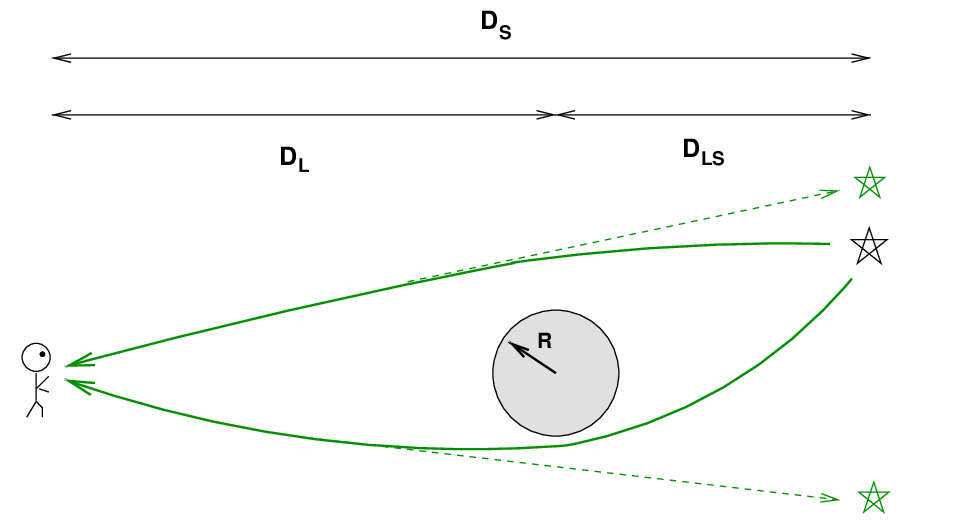
 Copyright © Michael Richmond.
This work is licensed under a Creative Commons License.
Copyright © Michael Richmond.
This work is licensed under a Creative Commons License.
Last time, we investigated the phenomenon of gravitational lensing. Today, we figure out how it can be used to measure the distances to certain very distant objects.
In our initial discussion of gravitational lensing, we chose systems in which the lensing object was aligned EXACTLY with the background source. In that case, the background source was distorted into a circular ring. We further considered only systems in which the lens was an equal distance away from the observer and the source -- exactly halfway in between.
However, in general, the lensing object does NOT line up exactly with the background source. That means that the source appears somewhat off-center.

In this situation, we will see two bright-ish, distorted images of the background source (I'm ignoring the fainter third image for now), one slightly closer to the lens, one slightly farther away.
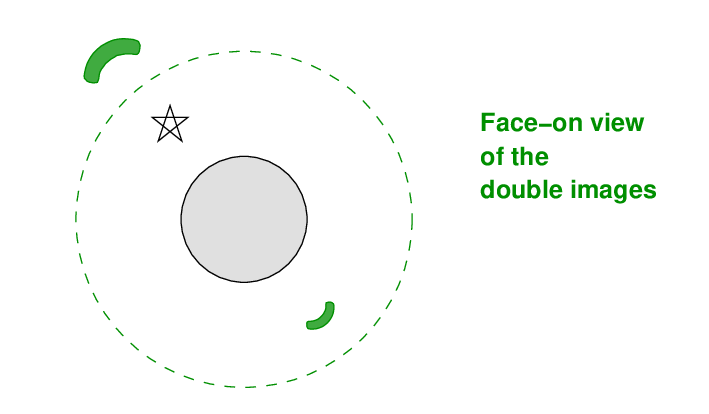
In addition, it is very likely that the lens does NOT lie exactly half-way between the source and the observer, so the geometry is more complicated: there are three distances we need to consider, not just one.

If we can
then we can make a good model of the system. One of the (many) problems in this approach is determining the absolute mass of the lensing object(s). In many cases, the best we can do is to create a set of models with different lens masses; all of them have the same RELATIVE distances, from observer to lens and from lens to background source, but the ABSOLUTE values are unknown.
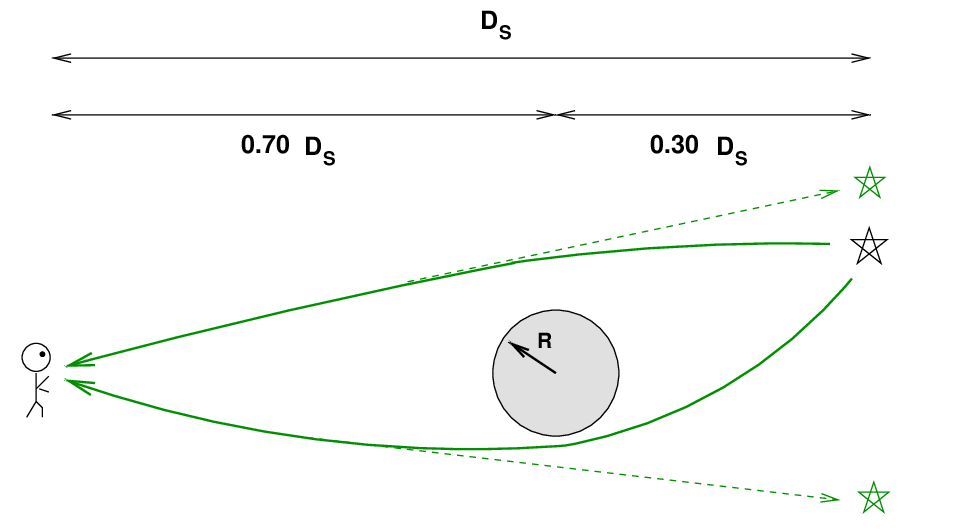
Is there some way to break the degeneracy? In other words, is there some way to establish unambiguously the mass of the lensing object and distance to the lens and source? The answer is yes, if we can detect variations in the relative brightness of the images.
The mathematics of a real gravitational lens system can be pretty complicated, so let's set up a simple analogy to see the idea behind this technique. Instead of light travelling along curved paths around a massive object, imagine that two automobiles are driving from Rochester to Cleveland, a distance D as the crow flies. Each car drives at a constant speed of v = 60 mph. One car takes the northern route, which is only slightly longer, 1.2 D, than the straight line; the other car takes a more circuitous southern route, which is considerably longer: 1.6 D.
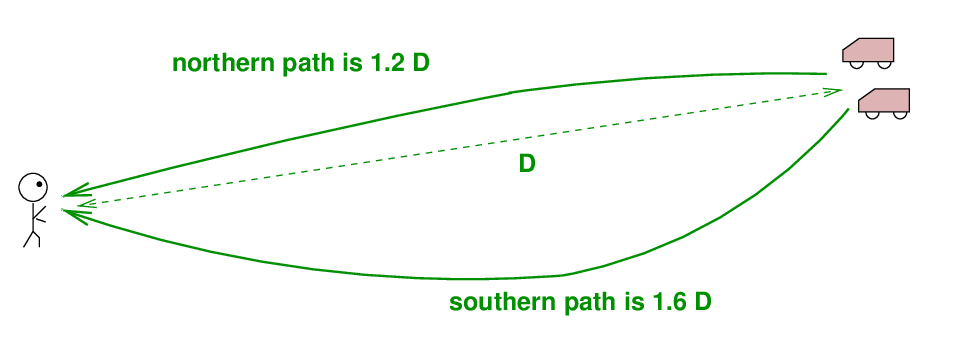
Both cars start driving at the same time -- which we don't know. Rats. However, we can measure the time when each car reaches us in Buffalo, and we determine that the car taking the northern path arrives 30 minutes earlier.
Q: What is the straight-line distance D between
Rochester and Buffalo?
See how that works? The key is to measure the DIFFERENCE in arrival time of the cars which travel along different paths.
Now, let's turn back to real objects in space. Consider the system RXJ 1131-1231. A long exposure with HST shows a bright, compact source with some fainter stuff around it:
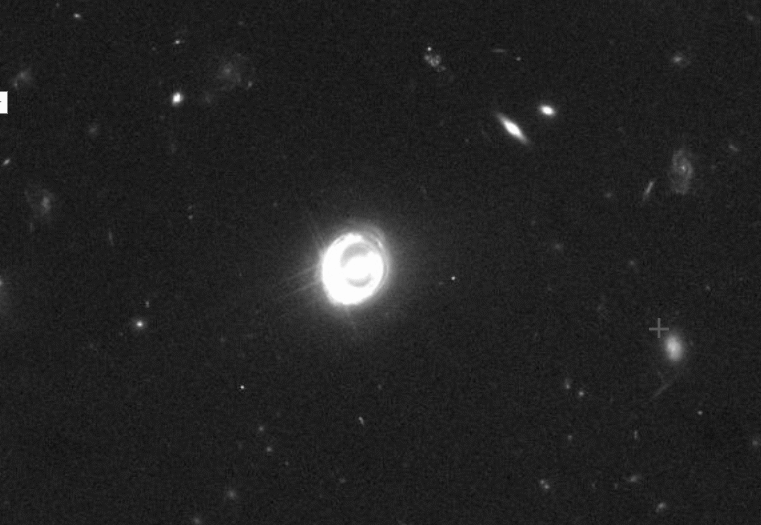
Image generated by the
Hubble Legacy Archive
But if we modify the contrast and zoom in on the object, we find a galaxy surrounded by a ring of light
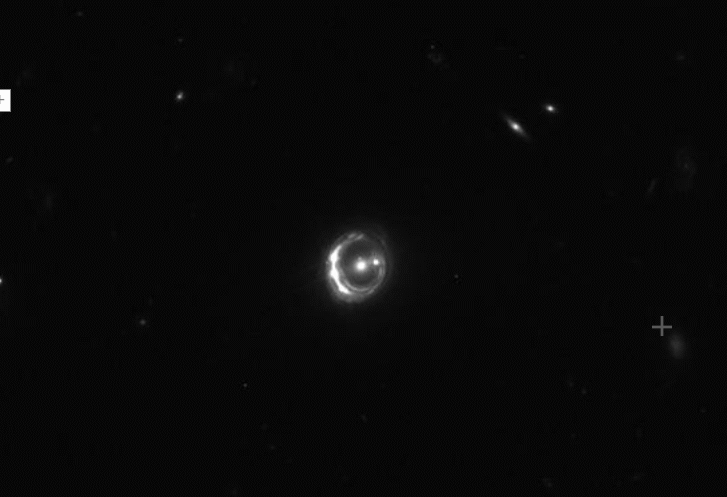
Image generated by the
Hubble Legacy Archive
and that ring has four point sources:
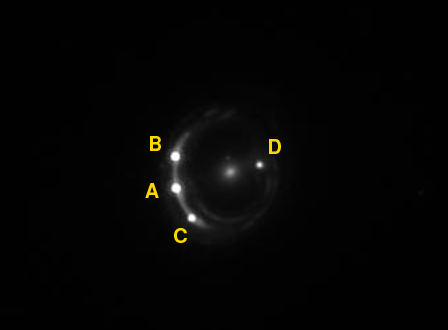
Image generated by the
Hubble Legacy Archive
In this instance, the central, diffuse object is a galaxy at a redshift z = 0.295 acting as a lens; and the four point sources are images of a background quasar at z = 0.658.
If one measures the brightness of each of the four images of the quasar over a long period, one will see gradual changes: the quasar itself has a luminosity which varies, as many do. But the four different images don't all appear to change at exactly the same time:

Data taken from
Vizier and Tewes et al., A&A 556, A22 (2013)
Q: Can you figure out the time delay between the image
shown in green (D) and the other images?
Grab the data from the link below. The Julian Date is in column 1,
and magnitudes for images A, B, C, D are in columns 2, 4, 6, 8,
respectively.
data file for RXJ 1131-1231 from Tewes et al. (2013)
data file for RXJ 1131-1231 from Tewes et al. (2013) (CSV version)
My quick attempts yielded a delay of about 90 days between the variations in the three brightest images (A, B, C) and the faintest image (D). Suyu et al., ApJ 766, 70 (2013) find a delay of 91.4 +/- 1.5 days.
If one can measure a time delay between images, and one has a good model for the mass of the lensing object(s), and one has the redshifts of the lens(es) and the source, then one can figure out the distance to each object; or, if one wishes, one can set constraints on various cosmological parameters. Suyu et al., ApJ 766, 70 (2013), for example, create a model with 39 (yes, 39!) parameters and perform many complex calculations to place constraints on them all. Their estimate for the "time-delay" distance for this object

is roughly 2100 Mpc.
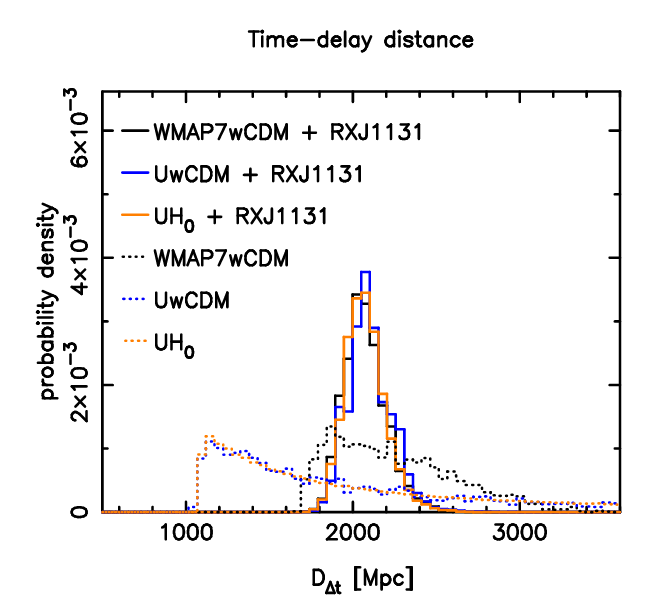
Taken from Figure 7 of
Suyu et al., ApJ 766, 70 (2013)
Moreover, they believe that this measurement of a really, really large distance has a small uncertainty:
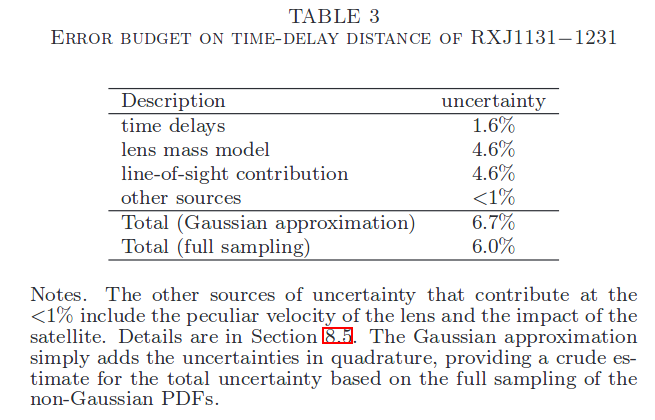
Table 3 taken from
Suyu et al., ApJ 766, 70 (2013)
In 2014, astronomers noticed a fortunate but improbable event, behind a mass clusters of galaxies called MACS J1149.5+2223 were a number of background galaxies. Some of these galaxies were lensed, creating multiple images.
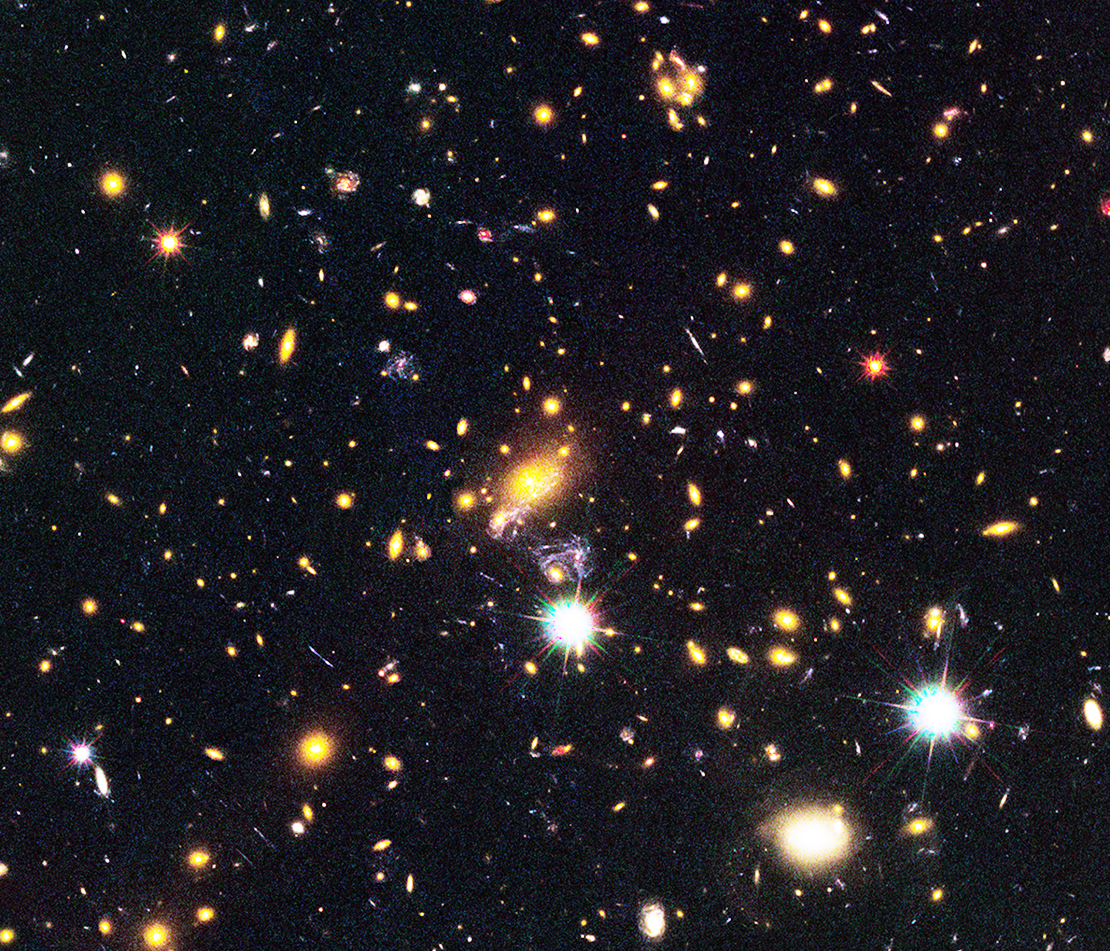
Image courtesy of
NASA, ESA, and M. Postman (STScI), and the CLASH team.
Let's zoom into the central region.
Q: Can you find three images of the same blueish galaxy?
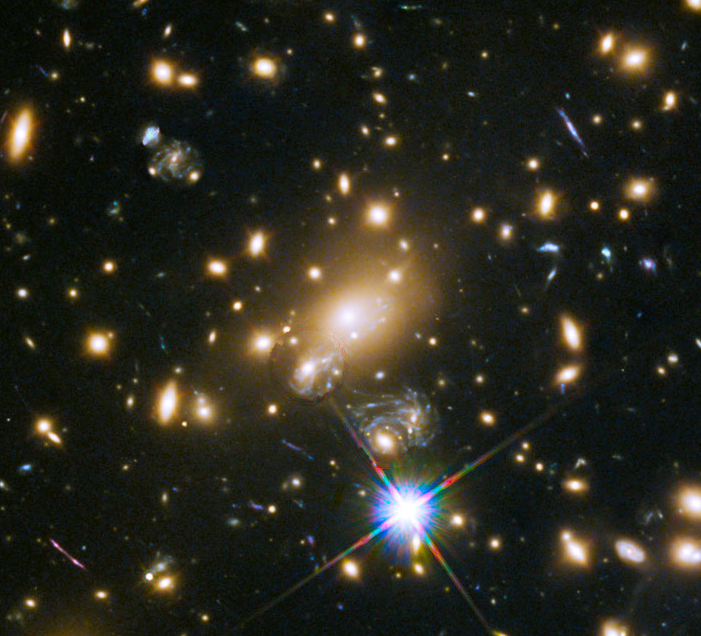
Image courtesy of
NASA, ESA, S. Rodney (John Hopkins University, USA) and the FrontierSN team; T. Treu (University of California Los Angeles, USA), P. Kelly (University of California Berkeley, USA) and the GLASS team; J. Lotz (STScI) and the Frontier Fields team; M. Postman (STScI) and the CLASH team; and Z. Levay (STScI)
There are many, many galaxies in this cluster, so making a model of the gravitational lensing is ... complicated. Nonetheless, some astronomers tried to account for the effects of all the galaxies, as well as the diffuse mass of the hot gas spread throughout the cluster. Grillo et al., ApJ 822, 78 (2016) identify all these objects (and more) as members of the cluster and place them into their model -- which ends up with 300 cluster galaxies and 3 concentrations of dark matter.
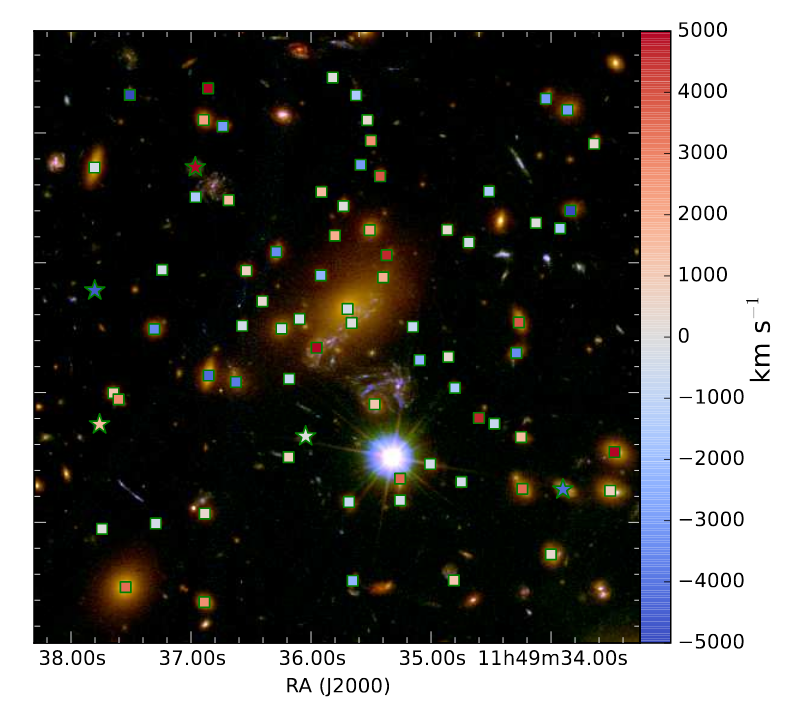
Taken from Figure 2 of
Grillo et al., ApJ 822, 78 (2016)
One can follow the light paths from the background galaxy through this model -- which includes distances to the lensing objects and background source objects -- and predict the time it takes light to travel along each path. The results are a bit counterintuitive: the closer the path is to the center of the system, the LONGER it takes light to travel.
Now, in 2014, something happened in this region of the sky: a supernova appeared, exploding within the highlighted background galaxy. Astronomers grew excited, because they realized how important a gravitationally lensed supernova could be. Back in 1964, Sjur Refsdal had described how a gravitationally lensed supernova might be used to measure very large distances. To honor his idea, this supernova became known as "SN Refsdal".
But we did not see just one image of this supernova -- we detected FOUR!
Look closely at the southernmost image of the lensed galaxy, in an image taken in November, 2014 (click on it for a larger version). One of the spiral arms of a distant, blueish, background galaxy happens to sit directly behind a reddish elliptical galaxy in the cluster ... and in that spiral arm, a supernova exploded!
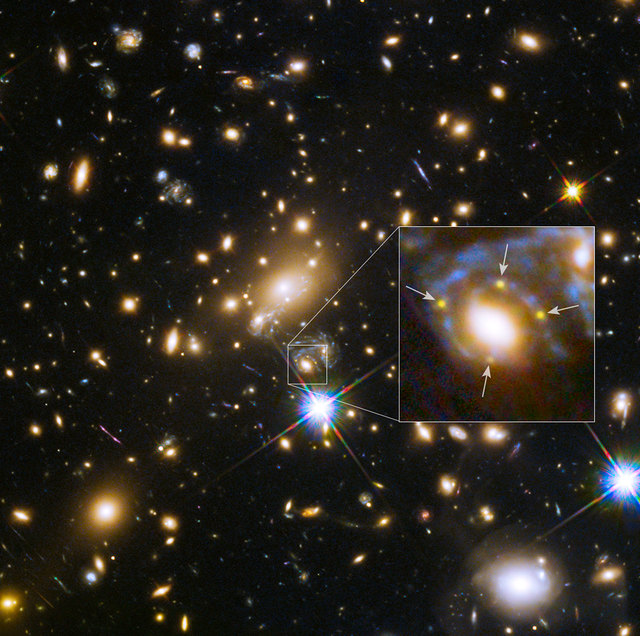
Image courtesy of
NASA, ESA, S. Rodney (John Hopkins University, USA) and the FrontierSN team; T. Treu (University of California Los Angeles, USA), P. Kelly (University of California Berkeley, USA) and the GLASS team; J. Lotz (STScI) and the Frontier Fields team; M. Postman (STScI) and the CLASH team; and Z. Levay (STScI)
Three of the SN images are easy to see, but the fourth one is a bit fainter. It helps to subtract away a model of the cluster galaxy which lies right in front of the background galaxy's spiral arm containing the SN.
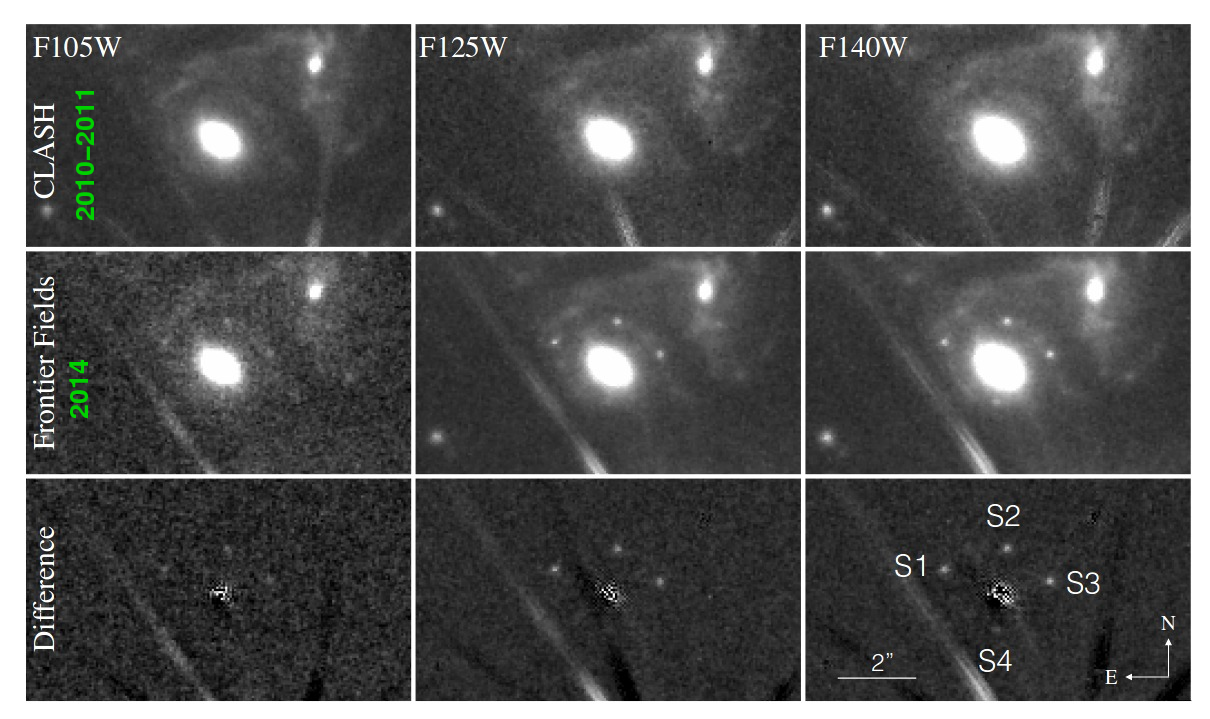
Image taken from Fig 1 of
Kelly et al., Science 347, 1123 (2015)
Because HST took several images of this region during 2014, scientists were able to determine
Putting this information into their models, Kelly et al., Science 347, 1123 (2015) examined the light-travel times along the paths to the other two locations of this galaxy. They suggested that light from the supernova might appear in the "latest" copy of the spiral galaxy (the one closest to the center of the cluster) at a future time, within a year to a decade from now (2015 to 2025).
Grillo et al., ApJ 822, 78 (2016) studied this system more carefully (with more time), and made (among other claims) one post-diction and one pre-diction. First, the light from this supernova should have appeared in the northernmost image of the galaxy about 6000 days ago, around 1995; but we don't have any images of this region taken at that time with sufficient detail to confirm this claim.
Second -- and more exciting -- they made a rather precise PRE-diction: according to their model, light from the SN would appear in the "latest" image of the galaxy at some point in the not-too-distant future: Their first attempt made a prediction that the delay would be "about a decade", but their second version (see Table 5) shows the delay between image S1 and the central location to be between 328 and 390 days.
Q: If the image S1 was first noticed in November, 2014,
when should an image of the SN appear in the "latest" location?
Grillo et al. submitted their paper to ApJ on 2015 November 12 (and it was received on 2015 November 15), so ... barely in time to make a real prediction. But they did.
So, what happened?
Let's zoom into this little region within the cluster, containing the two images in question.
The image below (click to animate) will show this region of sky in pictures taken in 2011 (before the four images), in Apr, 2015 (soon after the four images appeared), and then again in Dec, 2015.
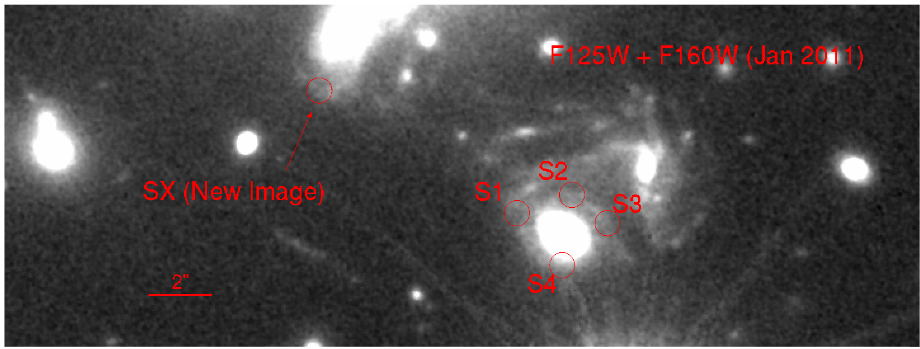
Image taken from 1 of
Kelly et al., ApJ 819, 8 (2016)
In December, 2015, the four SN images in the southernmost copy of the galaxy were fading -- but a new image (called "SX" in the pictures above) appeared in the central copy of the galaxy -- just as predicted, in time as well as in position:
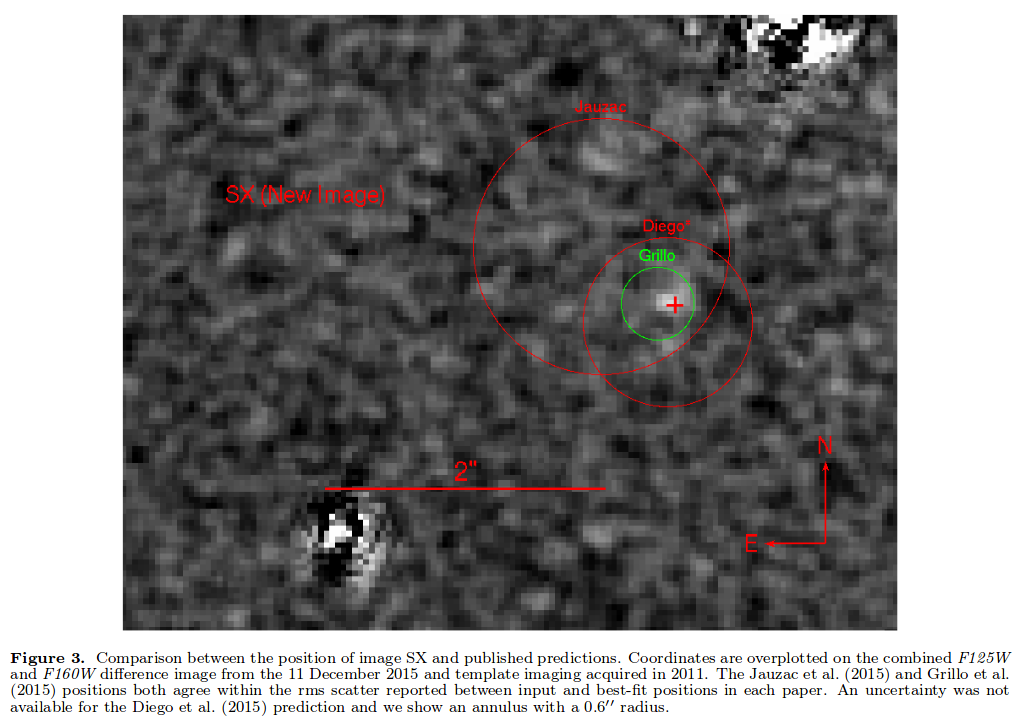
Figure 3 taken from
Kelly et al., ApJ 819, 8 (2016)
Hooray!
Light curves of the four images around the southern copy suggest that this was a Type IIP supernova, not very luminous, perhaps a distant cousin of SN 1987A.
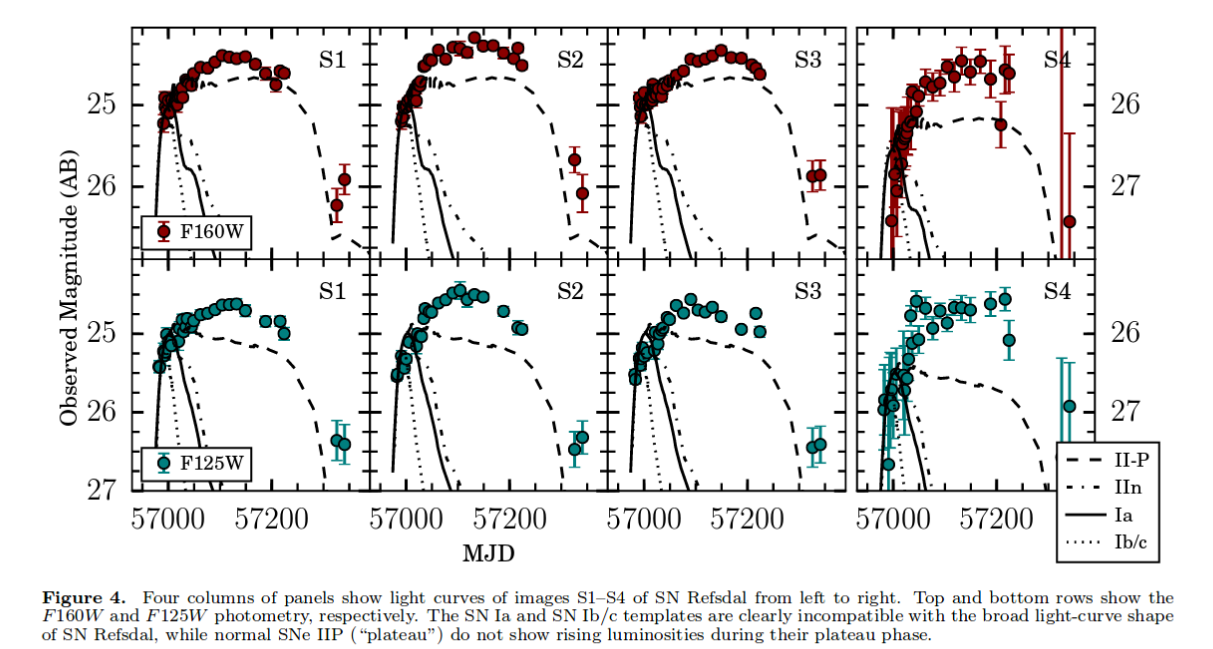
Figure 4 taken from
Kelly et al., ApJ 831, 205 (2016)
Unfortunately, we haven't been able to pin down the time delay between the more recent image "SX" and the well-observed image "S1". As a result, we don't know exactly how far away this supernova really was. As the figure below shows, there's a roughly linear relationship between the time delay and the distance to the supernova, or between the time delay and the value of H0 --- which depends upon the distance.
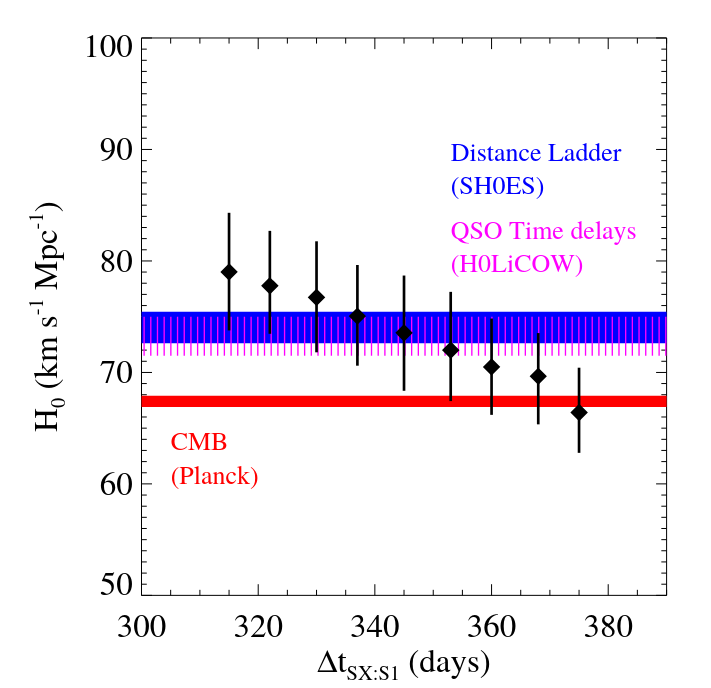
Figure 1 taken from
Grillo et al., ApJ 898, 87 (2020)
Chances are slim that we will catch many gravitationally lensed supernovae exploding over the next few decades, but since we can in theory detect them far beyond redshift z=1, they provide a mean to measure distances more deeply into space than any other method in our toolbox.
 Copyright © Michael Richmond.
This work is licensed under a Creative Commons License.
Copyright © Michael Richmond.
This work is licensed under a Creative Commons License.